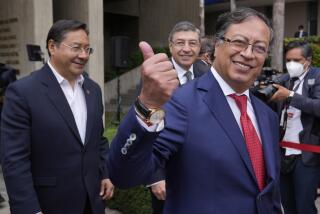‘To the Trenches, Companeros : Honduras Rockets Scatter Reporters and Sandinistas
- Share via
SAN ANDRES DE BOCAY, Nicaragua — A rocket fired by a Honduran fighter jet exploded on a riverbed in Nicaraguan territory Thursday, sending 30 correspondents and their Sandinista escort diving for cover.
Landing with an eerie screech, the rocket struck about 150 yards from this reporter, sending up a towering blast of dirt and debris that rained on others in the group ahead of me on the grassy riverside airstrip.
As the intruding warplane roared out of earshot, a Sandinista army public relations officer, Lt. Rosario Rivera, pulled herself from a ravine, pointed to a clump of trees and yelled: “To the trenches, companeros!”
By flying foreign and Nicaraguan journalists to this uninhabited jungle area Thursday, the Sandinistas intended to show they had ousted Contra rebels from a string of bases in northern Nicaragua and had refrained from pursuing them across the Coco River into Honduras.
While there were no rebels in sight, we watched the U.S.-backed Honduran government underscore its allegations of a Sandinista army invasion by sending jet bombers roaring high over the Coco into Nicaraguan airspace.
The Contras have base camps in Honduras, and these have been frequent Sandinista targets during the 6-year-old Nicaraguan war. But this was the first retaliatory Honduran air strike since December, 1986.
At least three rockets fell within sight of reporters during what apparently was a wider air raid against suspected Sandinista positions on both sides of the border.
The first rocket--dropped by a delta-winged jet, apparently a Super Mystere--landed on a hill on the Honduran side and created a thick plume of black smoke. Another landed on a nearby hill, also in Honduras.
At the time, Lt. Col. Javier Carrion, the Sandinista army deputy chief of staff, was briefing reporters on the Nicaraguan side of the Coco, where it meets the Bocay River.
Denying his forces were in Honduras, Carrion had led reporters to the river to look for themselves. The sudden rocket attack drew no apparent Sandinista retaliation from either shore, and it sent the colonel and the press scurrying toward an encampment about 300 yards away in the woods. It was during this retreat that the third rocket struck between the Bocay River and the adjacent airstrip.
Samuel Barreto, a Nicaraguan photographer on assignment for Time magazine, was the only person injured. He was cut on the forehead when he dove for cover and fell on his camera.
Darryl Hunt, whose New York public relations company represents the Sandinista government and who helped arrange the press trip, said he was about 100 yards from the explosion. He dove to the ground and was covered by dirt from the blast.
As soldiers herded reporters into trenches in the woods, they warned us to watch for land mines planted by the Contras before they fled the area.
Carrion said 4,500 Sandinista soldiers, backed by air force bombardment, drove about 1,800 Contras from six camps along the Coco River in the 10-day offensive that ended Wednesday. The number of government troops made it the largest known Sandinista operation of the war.
The camps were concentrated along a 6-mile stretch of the river between here and Wayawas. He said they included 120 shacks occupied by rebels and their families, who grew corn and beans and raised cattle.
“This was a major blow to them,” Carrion said. “This was their home. Their officers were here. They (the troops) came here to rest, to get medical treatment, new supplies, battle instructions and pay.”
Sandinista officers said they captured 70 packs of medicine, some food, land-mine detectors, shovels, pickaxes and several bags of worthless cordobas left over from before last month’s switch to a new national currency.
But despite reporting 92 dead and 300 wounded Contras, the Sandinistas said they captured no prisoners and few weapons--about 50 rifles and an unspecified quantity of explosives. The army drove the Contras from the Bocay River valley with a 3,000-man offensive last May, but Carrion said they quickly filtered back in.
More to Read
Sign up for Essential California
The most important California stories and recommendations in your inbox every morning.
You may occasionally receive promotional content from the Los Angeles Times.










